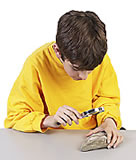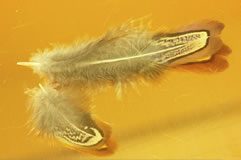 Realia and Models
Realia and Models
Real objects play an important role in the investigations of student information scientists. This "realia" may include tools, uniforms, inventions, coins, and other artifacts. Rocks, shells, bones, fur, skin, feathers and other natural objects are exciting, thought-provoking materials for learners of all ages. Some learning laboratories even support living collections including insects, plants, and animals.
These real objects provide opportunities for students to generate questions, make observations, and test ideas.
 Students may also use models and other representations to help them understand topics from the human body to the solar system.
Students may also use models and other representations to help them understand topics from the human body to the solar system.
The learning laboratory provides access to these materials. When it's not possible to house these objects, the school library media specialist reaches out to classroom teachers and community members. They may also digital materials and have visual and auditory representations available.
The following examples demonstrates how realia and models facilitate the learning experiences of the student information scientist.
The Snake Wranglers
 The local humane society contacted the school about a collaboration related to animal care. Having already worked on a nature center in the courtyard adjoining the library, Ms. Anderson was ready to bring nature into the center. A group of children called the Critter Wranglers care for the snake and manage the nature area.
The local humane society contacted the school about a collaboration related to animal care. Having already worked on a nature center in the courtyard adjoining the library, Ms. Anderson was ready to bring nature into the center. A group of children called the Critter Wranglers care for the snake and manage the nature area.

Explore Taylor's investigation for more detail.
Explore Ms. Anderson's involvement as an instructional specialist.
The Rockhounds
 The local rockhounding club has donated rock and mineral specimens to the school. As part of an earth science project, the fifth grade class is classifying and cataloging these rocks.
The local rockhounding club has donated rock and mineral specimens to the school. As part of an earth science project, the fifth grade class is classifying and cataloging these rocks.
Explore Nathan's investigation for more detail.
Explore Mr. Samuel's and Mr. Campbell's involvement as an instructional specialist.
Looking Closer
 Isabella enjoys looking at the world through a magnifying glass or microscope. She's particularly interested in collecting and viewing bird feathers. She spends lots of time in the nature area of the learning laboratory and was excited to see a huge bulletin board being set up by a group of children for a project called The Great Backyard Bird Count.
Isabella enjoys looking at the world through a magnifying glass or microscope. She's particularly interested in collecting and viewing bird feathers. She spends lots of time in the nature area of the learning laboratory and was excited to see a huge bulletin board being set up by a group of children for a project called The Great Backyard Bird Count.
Isabella expresses an interest to the school library media specialist. Ms. Anderson suggests that she might be a "project coordinator" helping Miss Hamilton and assisting the younger learners. She's thrilled with the idea of sharing her feather collection and helping with the bird count project. As part of the bird project she creates an exhibit of her best feathers to share.
Explore Isabella's investigation for more detail.
Explore Ms. Anderson's and Miss Hamilton's involvement as an instructional specialist.
